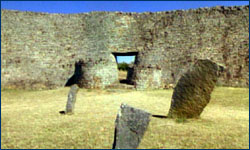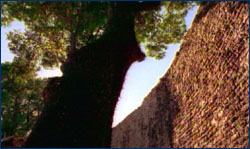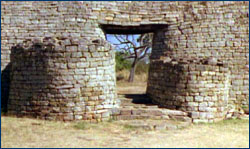
|

|
by Peter Tyson The first whispered reports of a fabulous stone palace in the heart of southern Africa began dribbling into the coastal trading ports of Mozambique in the 16th century. In his 1552 Da Asia, the most complete chronicle of the Portuguese conquests, João de Barros wrote of "a square fortress, masonry within and without, built of stones of marvelous size, and there appears to be no mortar joining them." De Barros thought the edifice, which he never saw, was Axuma, one of the cities of the Queen of Sheba. Other Portuguese chroniclers of the day linked the rumored fortress with the region's gold trade and decided it must be the biblical Ophir, from which the Queen of Sheba procured gold for the Temple of Solomon. This notion persisted for centuries, right up until the monument's 19th-century European "discovery." That distinction fell to a young German named Carl Mauch. In 1871, Mauch, eager to seek for the fabled ruins of Ophir, penetrated deep into what is today southern Zimbabwe. In August, he reached the home of a lone German trader, who told him of "quite large ruins which could never have been built by blacks." On September 5, local Karanga tribesmen led Mauch to the site. In the midst of a wooded savanna backed by bare granite hills stood a city of stone. Its beautifully coursed walls curved and undulated sinuously over the landscape, blending into the boulder-strewn terrain as if having arisen there naturally. Bearing no mortar, as de Barros had correctly heard, the walls nevertheless reached enormous height, standing as high as 32 feet over the surrounding savanna. Of fully 100 acres of these granite enclosures, not a single one was straight. Mauch was looking at the greatest pre-Portuguese ruins of sub-Saharan Africa.
Unfortunately, Mauch, for all his tenacity, was "no thinker," as Peter Garlake, author of the definitive archeological text on Great Zimbabwe, deemed him. And Mauch only boosted the Portuguese theories of three centuries before. The soapstone and iron relics he uncovered told him that a "civilized [read: white] nation must once have lived there." From a lintel, he cut some wood that he described as reddish, scented, and very like the wood of his pencil. Therefore, he concluded, the wood must be cedar from Lebanon and must have been brought by Phoenicians. And therefore, the Great Enclosure—the edifice's most impressive structure, which local Karanga called Mumbahuru, "the house of the great woman"—must have been built by the Queen of Sheba. As it turns out, Mauch's description of the wood aptly characterizes the African sandalwood, a local hardwood that later visitors also found in the walls of the Great Enclosure. But no one would know that for years. In the meantime, Mauch's line of reasoning, distinguished as it was by the most purblind logic, perfectly suited Cecil Rhodes, whose British South Africa Company (BSA) occupied Mashonaland in 1890. (Mashonaland lies just to the north of Great Zimbabwe.) Inextricably steeped in his native country's racist views, Rhodes bought into Mauch's take without a second thought. Indeed, on Rhodes' first visit to the site, local Karanga chiefs were told that "the Great Master" had come to see "the ancient temple which once upon a time belonged to white men."
All the artifacts Bent subsequently uncovered screamed "indigenous." Pottery sherds and spindle whorls; spearheads of iron, bronze, and copper; axes, adzes, and hoes; and gold-working equipment such as tuyères and crucibles—all were very similar to household objects used by the local Karanga. Yet Bent, incapable of following where the evidence might lead him, concluded ("a little lamely and nebulously," notes Garlake) that "a prehistoric race built the ruins ... a northern race coming from Arabia ... closely akin to the Phoenician and Egyptian ... and eventually developing into the more civilized races of the ancient world." Bent was amateurish and narrow-minded but not utterly incompetent. The same could not be said of Richard Nicklin Hall, a local journalist and author of The Ancient Ruins of Rhodesia. In what would prove to be one of the most sickeningly misguided assignments in the history of archeological preservation, the BSA appointed Hall Curator of Great Zimbabwe, with a mandate to undertake "not scientific research but the preservation of the building." Instead, Hall, hell-bent on finally settling the issue of its origins, launched into a full-scale "archeological" investigation. Claiming he was removing the "filth and decadence of the Kaffir occupation," he scoured the site for signs of its white builders, discarding from three to 12 feet of stratified archeological deposits throughout Great Zimbabwe. An archeologist who visited the site shortly after Hall left deemed his fieldwork "reckless blundering ... worse than anything I have ever seen." Word eventually got back to the BSA of Hall's desecration of southern Africa's greatest archeological treasure, and he was dismissed. But the damage had been done. "Hall's disastrous activities left only vestiges of archeological deposits within the walls," wrote Garlake in his book Great Zimbabwe, "a paucity that was to inhibit all future scientific work." Continue: Randall-MacIver investigates the site Where are the Ten Lost Tribes? | Tudor Parfitt's Remarkable Journey Mystery of Great Zimbabwe | Build a Family Tree | Resources Teacher's Guide | Transcript | Site Map | Lost Tribes of Israel Home Editor's Picks | Previous Sites | Join Us/E-mail | TV/Web Schedule About NOVA | Teachers | Site Map | Shop | Jobs | Search | To print PBS Online | NOVA Online | WGBH © | Updated November 2000 |
 Inside the Great Enclosure at Great Zimbabwe.
Inside the Great Enclosure at Great Zimbabwe.
 The highest of Great Zimbabwe's walls soar 32 feet
above the surrounding savanna.
The highest of Great Zimbabwe's walls soar 32 feet
above the surrounding savanna.
 All artifacts that Theodore Bent turned up pointed to
an indigenous origin to Great Zimbabwe and its people,
but he would have none of it.
All artifacts that Theodore Bent turned up pointed to
an indigenous origin to Great Zimbabwe and its people,
but he would have none of it.